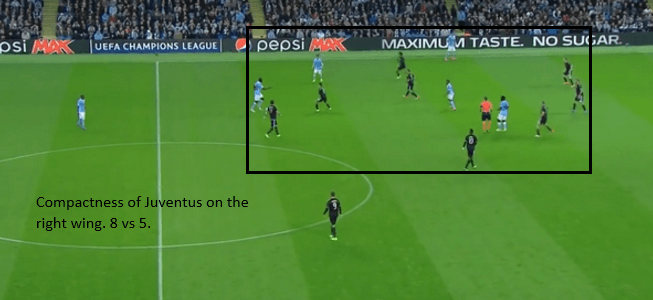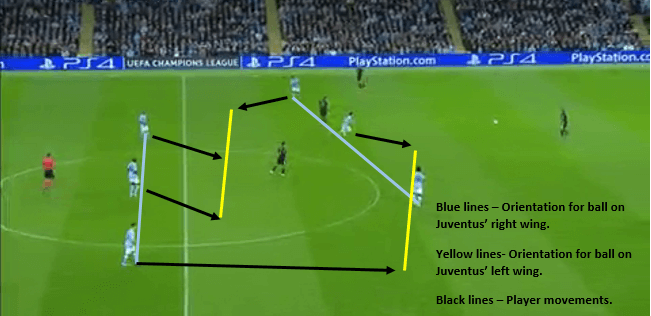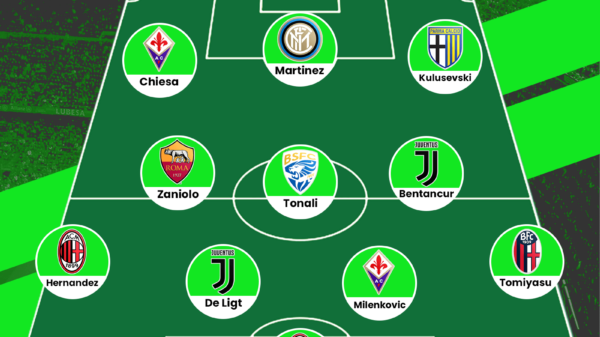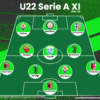Manchester City, still undefeated and yet to concede a goal prior to Juventus match, had nothing to change in its strategy and Manuel Pellegrini approached the game with a 4-4-2 formation.
Juventus, who have not yet tasted victory in Serie A this term, focused more or the defensive structure. Massimiliano Allegri adopted a 4-3-3 formation and Juventus were changing regularly to 4-5-1 when out of possession.
Manchester City 1-2 Juventus
Line Ups

Manchester City: 1. Hart; 3. Sagna, 4. Kompany, 20. Mangala, 11. Kolarov; 42 Toure, 25. Fernandinho; 8. Nasri, 21. Silva, 7. Sterling; 14. Bony.
Juventus: 1. Buffon; 26. Lichtsteiner, 19. Bonucci, 3. Chiellini, 33. Evra; 27. Sturaro, 11. Hernanes, 10. Pogba; 16. Cuadrado, 17. Mandzukic, 9. Morata.
Juventus’ 4-5-1 structure in the defensive phase
Allegri who fielded two strikers, Alvaro Morata and Mario Mandzukic, used Morata as the left winger to change Juventus’ formation to 4-5-1. The back four of Patrice Evra, Giorgio Chiellini, Leonardo Bonucci, and Stephan Licthsteiner was very narrow and in resonance to this the wide players of midfield five covered the wide spaces.
Yaya Toure and Fernandinho usually stayed deep during City’s build ups, Bacary Sagna and Kolarov were usually occupied by Morata and Juan Cuadrado respectively and Silva’s movements were very closely watched by Hernanes. So it was very tough for both the central midfielders to pick out the right players for the build up towards the goal. In short, Juventus’ five men midfield blocked the passing options of Manchester City.
This also helped Juventus in being compact in the direction of City’s build up. If City were attacking through Kolarov, then Mandzukic was moving towards the midfield to cut-off his passing option there and was pressing from the back. Morata was roaming around in the space in the far side. Cuadrado, Lichtsteiner, Stefano Sturaro, and Hernanes were just shifting towards that wing. This was bottle-necking City’s path and they were forced to shift the ball the other wing. Juventus were then zonally shifting from right to left.
Pressing traps on the wings by Juventus
In City’s attacking build-ups through the wings, especially the left one – by Kolarov and Raheem Sterling, there was already numerical equality due to the presence of Cuadrado and Lichtsteiner. With Mandzukic pressing from back and Hernanes and Sturaro shifting towards the left wing, it was creating a 5 vs. 4 situation even with the involvement of Silva and one of the central midfielders.
Here’s one such case. Juventus are outnumbering City in the red zone 3 vs. 2. Silva and Kolarov are marked by Mandzukic (M) and Hernanes (blue marks). Cuadrado’s (C) run here is further increasing the pressure on the ball receiver.

Juventus negate City’s threat though the middle using Paul Pogba, Hernanes and Sturaro

This picture completely shows us what Juventus were up to at the Etihad Stadium. They maintained a 4-5-1 structure, as said before. The narrow positioning of Pogba, Hernanes and Sturaro enabled them to control the central zones of their half. City were not able to find a way through the middle and were just circulating the ball around the center circle. The wingers were just forcing the attacking moves away from the wings and the narrow central midfield trio were blocking the moves through the middle. It allowed Juventus to be more compact in the side where the ball was being played.

Six City players (Vincent Kompany, Eliaquim Mangala, Kolarov, Sagna, Toure, and Fernandinho) were involved in the build-up, which eventually ended up safely in Gianluigi Buffon’s hands. The involvement of six players in front of the line of pressure meant that City had only 4 players behind it, who were quite easily controlled by Juventus’ back four.
Juventus were also trying to snatch the ball from City’s players by using two players to press them in the central areas. One of them was Mandzukic and other one was usually one of the three central midfielders. In the pictures below, you can see Pogba and Sturaro stepping up.

Attacking advantages of the midfielders
Juventus found the advantage of having three men in midfield while attacking as well. The movements of the three players plus in the inside movements of the either Morata or Cuadrado was giving superiority and the space to play for Juventus.

Pogba was dropping deep towards the left and increasing the space between the lines. This was allowing Morata to run into the space and pose problems to City’s defensive setup. Pogba was also targeting the forwards with his crosses into the box. The numerical superiority in favor of the visitors made the City players work hard and unknowingly open up gaps in the middle.

Manchester City 4-4-2 high press and change to situational front three to press more effectively
Manchester City’s 4-4-2 structure was never helpful to the players in pressing high very effectively. Juventus were able spread out easily and Hernanes was getting behind the line of press and was providing safe passing options for Buffon.

The space left open behind the line of press was so much that, if it was left unoccupied by City midfielders then Hernanes was finding it easy to link the defense and attack of Juventus. If either Toure or Fernandinho stepped up, there was increase in space between the lines of midfield and defense.

Even though City’s midfield line pushed forward to cover this space behind the two pressing forwards (Silva and Wilfried Bony), they were still being out-numbered three to two in the central areas, and the wingbacks and wingers were always ready to launch the attacks. A case of City’s high press with 4-4-2 is shown below. During such situations Juventus were changing to 3-4-3, which was not so good from the home team’s perspective.

To counter this, City changed pattern to situational from three. The front three was changing from Sterling – Bony – Silva to Samir Nasri – Silva – Bony as the ball was shifting from one side to the other of Juventus defense. The pressing pattern was ball oriented.

However, with Morata and Cuadrado drifting in, it was always a tough job for City to press properly and fend off the attacks through the middle.
Manchester City players were able to position themselves in a 4-4-2 defensive formation when Juventus were building the attacks slowly. But when they were dispossessing the home players higher up the pitch, City were having trouble. City, by not adopting a suitable high-pressing strategy, was finding it very tough to regain a stable defensive structure quickly.

Juan Cuadrado’s contribution
Cuadrado started as the left winger for Juventus last night. But his work rate, pace and ability to play as a wingback helped Juventus a lot – both defensively and offensively. Lichtsteiner was sitting narrow and Cuadrado was slipping in beside him to reinforce the Old Lady’s defense to face the onrush of Kolarov and Sterling.
He was also helping Juventus change to back three for the smooth progression of the ball from the back. The Colombian was acting as the right-wingback while Lichtsteiner, Bonucci and Chiellini formed the three central defenders. Juventus were having at least three men up against Manchester City’s defenders in such situations.


Kevin de Bruyne and Sergio Aguero’s introduction
In search for more sharpness in the final third, Pellegrini introduced De Bruyne and Aguero. City manager needed someone to finish of properly the crosses put in from the wings. Kolarov was regularly breaking down the left flank and crossing to the middle only to be missed by Bony. Sterling was quick and finding the gas well but he was wasting genuine chances.
Juventus’ response to Aguero’s introduction
Andrea Barzagli, another central defender was sent on in place of Morata which made Juventus much more defensive as a response to the changes made by Pellegrini. With a back five and Sturaro and Hernanes just ahead of them, Juventus denied City any clear cut chances through the middle. Cuadrado and Lichtsteiner blocked De Bruyne while Pogba and Evra stopped Silva.
Conclusion
In search of a much needed victory, Allegri approached the game with a good defensive plan to back the attacking options he had upfront. Using three central midfielders to Toure and Co, using a low block to deny Silva and playing Cuadrado on the right wing (City’s left, where they pose threats from Kolorov and Sterling) was such a good tactical plan from the Italian to deny his Chilean counterpart a winning start in Europe.
Written by Nachiketh Ramesh and Monjur EK (@couchtacticians)
- Hipster Guide 2016-17: Fiorentina’s tactics, key players and emerging talents - August 17, 2016
- Euro 2016 Tactical Analysis: Germany 1–1 Italy (6-5 Pens) | Germany and Italy play almost similar systems - July 5, 2016
- Euro 2016 Tactical Analysis: England 1 – 2 Iceland | Tactically disciplined Iceland kicks England out of Europe. - June 29, 2016


























































